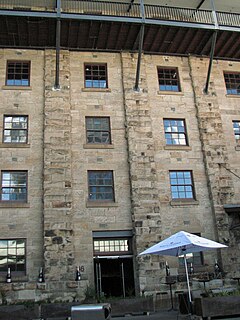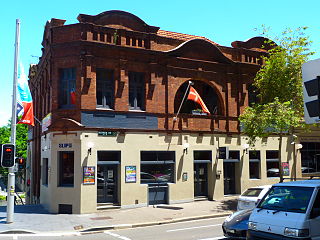
Ultimo is an inner-city suburb of Sydney, New South Wales, Australia.

Queensland Primary Producers No 4 Woolstore is a heritage-listed warehouse at 16 Skyring Terrace, Teneriffe, City of Brisbane, Queensland, Australia. It was built from 1930s to 1940s. It is also known as Commercial House. It was added to the Queensland Heritage Register on 21 October 1992.

Goldsbrough Mort Woolstore is a heritage-listed warehouse at 88 Macquarie Street, Teneriffe, City of Brisbane, Queensland, Australia. It was built c. 1933 by Stuart Brothers (Sydney). It was added to the Queensland Heritage Register on 21 October 1992.

Winchcombe Carson Woolstores is a heritage-listed warehouse at 54 Vernon Terrace, Teneriffe, City of Brisbane, Queensland, Australia. It was designed by architect Claude William Chambers and built in 1910-11 by Stuart Brothers of Sydney who extended it in 1934. The woolstore was added to the Queensland Heritage Register on 21 October 1992.

Australian Mercantile Land & Finance Woolstores is a heritage-listed former warehouse now apartments at 34 Vernon Terrace, Teneriffe, City of Brisbane, Queensland, Australia. Designed by Robin Dods of Hall and Dods, the first woolstore was built in 1912 by Walls & Juster and the second was built in 1922. They were added to the Queensland Heritage Register on 21 October 1992.

Teneriffe Village is a heritage-listed warehouse at 110 Macquarie Street, Teneriffe, City of Brisbane, Queensland, Australia. It was built from 1955 to 1957. It is also known as Dalgety & Co. Ltd No 3 Woolstore, Queensland Primary Producers, No 8 Woolstore, and Paddys Market. It was added to the Queensland Heritage Register on 21 October 1992.

The Ultimo Road railway underbridge is a heritage-listed former railway bridge located on the former Darling Harbour goods railway line in the inner city Sydney suburb of Ultimo in the City of Sydney local government area of New South Wales, Australia. It was designed by engineering staff in the Existing Lines branch of the New South Wales Public Works Department and built in 1879. The property is owned by RailCorp, an agency of the Government of New South Wales. It was added to the New South Wales State Heritage Register on 2 April 1999.

The Ultimo Sewage Pumping Station is a heritage-listed sewerage pumping station located at William Henry Street in the inner city Sydney suburb of Ultimo in the City of Sydney local government area of New South Wales, Australia. As a result of the construction of an elevated roadway along William Henry Street, the pumping station now fronts Pyrmont Street, with vehicles being required to enter via Quarry Street, then turning right into Pyrmont Street.

The Hydraulic Pump Station is a heritage-listed former hydraulic power station and now bar at 17 Little Pier Street, Haymarket, City of Sydney, New South Wales, Australia. It was built from 1889 to 1891. It was added to the New South Wales State Heritage Register on 2 April 1999.

The Old Bushells Factory is a heritage-listed former Bushells Tea factory and warehouse, now used as shops, offices and an art gallery, located at 86-88 George Street in the inner city Sydney suburb of The Rocks in the City of Sydney local government area of New South Wales, Australia. No. 86 was designed by Walter Liberty Vernon; and both buildings were built from 1886 to 1912. It is also known as the Old Bushells Factory and Warehouse; Bushells Place; Bushells Warehouse and Bushells Offices; and Health Commission Building (Bushell's). The property is owned by Property NSW, an agency of the Government of New South Wales. It was added to the New South Wales State Heritage Register on 10 May 2002.

The Metcalfe Bond Stores is a heritage-listed former bond store and warehouse and now shops and offices located at 68-84 George Street in the inner city Sydney suburb of The Rocks in the City of Sydney local government area of New South Wales, Australia. It was built from 1912 to 1916. It is also known as New Metcalfe Bond Stores. The property is owned by Property NSW, an agency of the Government of New South Wales. It was added to the New South Wales State Heritage Register on 10 May 2002.

The MSB Stores Complex is a heritage-listed former warehouse and gas manufacturing plant and now offices and storage located at 2-4 Jenkins Street, in the inner city Sydney suburb of Millers Point in the City of Sydney local government area of New South Wales, Australia. It was built from 1844. It is also known as Maritime Services Board Office and Store and Australian Gas Light Company Stores and Offices. It was added to the New South Wales State Heritage Register on 18 April 2000.

The Oswald Bond Store is a heritage-listed former wool bond store and now offices at 1-17 Kent Street, in the inner city Sydney suburb of Millers Point in the City of Sydney local government area of New South Wales, Australia. It was designed by A. L. & G. McCredie and built by J. R. Locke. It is also known as Hentsch's Bond Store. It was added to the New South Wales State Heritage Register on 2 April 1999.

The Walsh Bay Wharves Precinct, also known as the Walsh Bay Arts Precinct, is a heritage-listed former wharf precinct, now converted to hospitality and entertainment purposes, at Hickson Road, in the inner city Sydney suburb of Millers Point in the City of Sydney local government area of New South Wales, Australia. It was designed by H. D. Walsh, who also supervised its construction from 1912 to 1921. It includes the MSB Bond Store No. 3 and the Parbury Ruins. It was added to the New South Wales State Heritage Register on 2 April 1999.

Dalgety's Bond Stores is a heritage-listed former warehouse complex and now commercial building located at Munn Street, in the inner city Sydney suburb of Millers Point in the City of Sydney local government area of New South Wales, Australia. It was built in 1875. It is also known as Munn Street Bond Stores. It was added to the New South Wales State Heritage Register on 2 April 1999.

Hinchcliff House is a heritage-listed former wool store, hostel for homeless men and university campus at 5–7 Young Street, Sydney, City of Sydney, New South Wales, Australia. The southern section was built c. 1860, while the northern section was built in the 1880s. It is also known as Hinchcliff's Woolstore, Ozanam House and EF House. It was added to the New South Wales State Heritage Register on 2 April 1999.

Royal George Hotel is a heritage-listed pub located at 115–117 Sussex Street, in the Sydney central business district, in the City of Sydney local government area of New South Wales, Australia. It was built in 1903. The adjoining former Cuthbert's Patent Slip building, assumed to date from 1869 and also heritage-listed, has also been incorporated into the hotel complex in recent decades. The hotel now operates as the Slip Inn. It was added to the New South Wales State Heritage Register on 2 April 1999.

73 York Street is a heritage-listed former warehouse and now office building located at 73 York Street, in the Sydney central business district in the City of Sydney local government area of New South Wales, Australia. It was built in 1892, with the design having been attributed to Herbert S. Thompson. It is also known as Henley House, Hardware House, ICLE House, Monte Paschi House and Cassa Commerciale House. It was added to the New South Wales State Heritage Register on 2 April 1999.

121-127 Sussex Street is a heritage-listed former warehouse and now commercial office building located at 121-127 Sussex Street, in the Sydney central business district, in the City of Sydney local government area of New South Wales, Australia. It was built during 1850. The property is owned by Property NSW, an agency of the Government of New South Wales. It was added to the New South Wales State Heritage Register on 2 April 1999.

The Bulletin Place Warehouses are a series of three heritage-listed former warehouses and now souvenir sales office, commercial offices, health club, storage area, and restaurant located between 6–18 Bulletin Place, in the Sydney central business district in the City of Sydney local government area of New South Wales, Australia. The warehouses were built from 1880 and have variously been known as the San Francisco Restaurant. The property is privately owned. It was added to the New South Wales State Heritage Register on 2 April 1999.





















